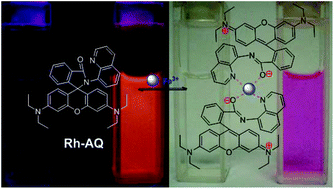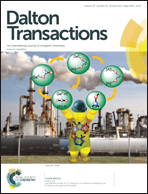Rhodamine-based fluorescent off–on sensor for Fe3+ – in aqueous solution and in living cells: 8-aminoquinoline receptor and 2 : 1 binding†
Abstract
8-Aminoquinoline (8-AQ) and 2-aminopyridine (AmPyr) both as ionophoric agents were robustly used in development of a cation sensor. To evaluate the effect of complexation with cations, flexible 2-aminopyridine and rigid 8-AQ moiety were directly introduced into rhodamine chromophore and two candidate fluorescent sensors were constructed successfully. Rh-AQ with a rigid 8-AQ fragment exhibited turn-on fluorescence and color responses to Fe3+ ion over other metal ions related to biology in aqueous solution. The sensor Rh-AmPyr with a flexible 2-aminopyridine did not give positive responses to cations although with a similar binding cavity as on Rh-AQ. Furthermore, the 2 : 1 recognition mode of Rh-AQ with Fe3+ was proved according to the 1D and 2D COSY H–H NMR experiments. The live cell imaging experiments demonstrated that Rh-AQ could be successfully applied as a bioimaging agent for monitoring Fe3+ in living cells.


 Please wait while we load your content...
Please wait while we load your content...